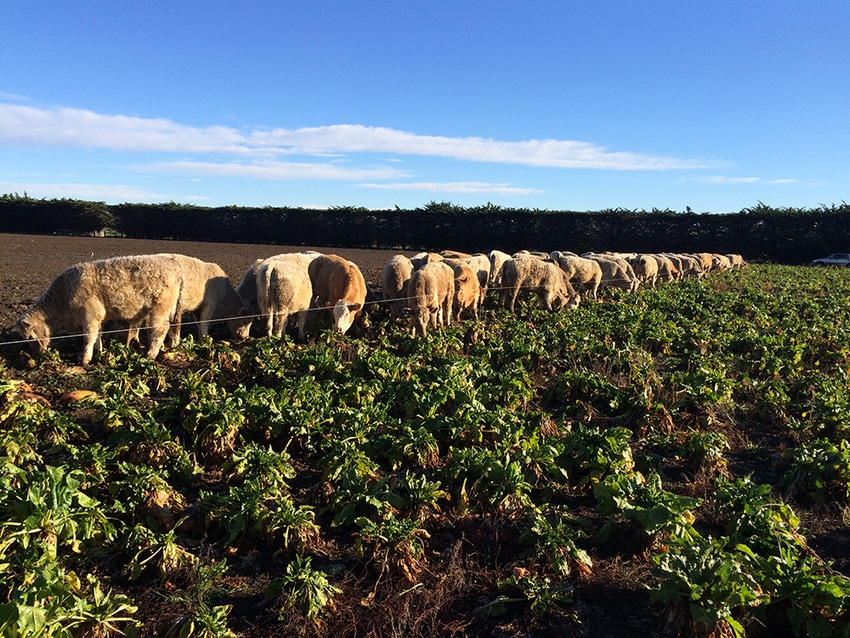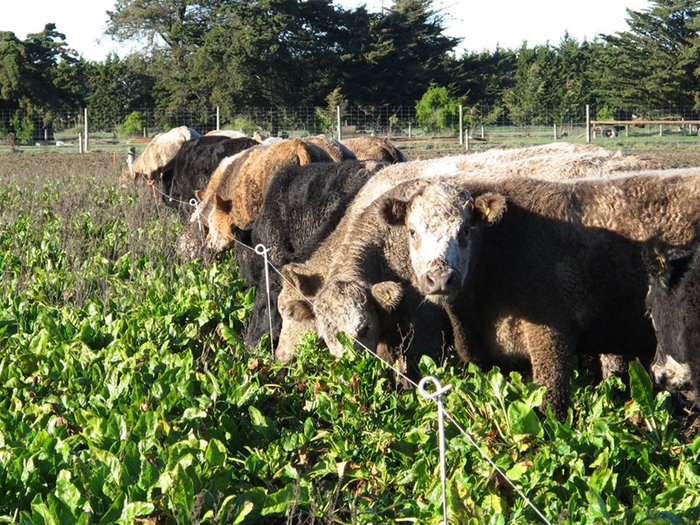Research shows grass-fed cattle can be finished on beet forage.
July 25, 2019

By Jim Gibbs, B.VSC, PhD
In recent years there has been a steady increase in the grass-fed beef market in the U.S., and the premium prices have drawn more producers into this sector of the industry. This has led to a renewed interest in pasture and forage feeding approaches, and it has also led to an increasing awareness of the seasonal limitations of grazing and how this impacts farm productivity.
In New Zealand, there is a long history of pasture and forage feeding as there is no grain production or feedlotting, and with a mild temperate climate, beef production is able to utilize all-season grazing. As a result, to push productivity, sophisticated methods of pasture management have been developed.
However, in any pasture system, seasonal feed quality and supply still impact beef production. In New Zealand, the lower pasture growth in both cold winters and dry summers acts to reduce annual stocking rates and increases the time to slaughter age.
Processor data from over 10 years has shown age at slaughter weight (1,200-1,300-plus pounds) for more than 90% of steers is 26-36 months. For processors, this brings challenges around variability in meat quality and also continuity of supply in low seasons for beef.

Over the past decade, a joint project between Lincoln University and a South Island beef operation, Silverstream Beef, developed a novel solution to seasonal feed deficits on beef farms by grazing the forage crop fodder beet.
Fodder beet or mangels (Beta vulgaris subsp vulgaris var. Crassa) is an older cousin of sugar beet, but has different agronomy to drive the grazing requirement for lots of leaf and higher nitrogen content in the bulbs. Spring planted, it is grazed from mid-autumn through winter until late spring.
The forage is strip-grazed directly out of the ground at unrestricted intakes, so there are no harvesting costs nor a need for wide rows. As a result, New Zealand yields are unusually high (>15 U.S. tons dry matter per acre) which provides a low-cost feed (about U.S. $60 per ton dry matter). It is also high value feed, with an energy content similar to cereals and a protein content of 11-13%, which suits beef finishing.

The Lincoln research, which took place prior to any cattle grazing applications being developed, was the driver for fodder beet use in New Zealand. The plant has been fed for centuries in Europe under a mistaken idea that it was toxic, so must be fed in small amounts. The Lincoln research demonstrated conclusively that the cause of stock illness was simply rumen acidosis as a result of the high sugar content and provided clear and simple guidelines for adaptation that enabled ad libitum intakes to be achieved without harm.
New Zealand systems
As a result, two fodder beet grazing systems are commonly used today for beef finishing. In the first, spring-born weaners at 600 pounds and 6-7 months old are strip-grazed on the forage crop exclusively for 130-150 days from mid-autumn, with weight gains of 2.2 pounds per day. The stocking rate is about 10 per acre on the crop.
Once the spring grass growth is strong, they are then grazed at 3 per acre on pasture for at least 90 days to a slaughter weight of 1,200-1,300 pounds at 14-16 months old, with a carcass yield of 56-58%.
The second beef grazing system uses 18-month-old cattle at 900 pounds, at 10 cattle per acre. They graze the beet crop from late autumn for 90-110 days, then are slaughtered directly off the crop at 1,200-1,300 pounds or above.
As this system only requires the crop acreage, it lends itself to large herds and extreme efficiency within the season, with per-acre carcass outputs of 7,300 pounds per year. As a result, there are now numerous operations with 2,500-5,000 cattle finished annually across New Zealand.
The primary benefit of beet grazing systems is to increase on-farm productivity by providing large yields of high energy feed in summer and autumn to be ‘banked’ for winter and early spring grazing, without seasonal decline in feed quality. This provides for high stocking rates at vulnerable points in the production cycle, while bringing forward the sale of slaughter stock to maintain high carcass quality.
Both these systems lift whole-farm stocking rates significantly, from 1 per acre rising to 4 per acre across the entire production cycle when comparing traditional pasture systems with integrated beet-pasture systems.
Beet grazing systems have proved practical and profitable, and farmer uptake has been the fastest in New Zealand history for any forage, with 170,000 acres sown annually within 10 years of discovery.
Will it work in the U.S.?
I get asked frequently if beet grazing systems could be profitably used in the U.S. beef industry. In the forage fed sector, my answer is yes.
The limitations to higher productivity of pasture-based beef production on-farm in the U.S. are similar to New Zealand. Therefore, it is likely that various regions in the U.S. could use these beet grazing systems as well. Where there are winters suitable for grazing, adequate water for the forage to achieve baseline yields, and a significant pasture-based beef industry, fodder beet grazing systems are suitable for use.
The use of beet grazing in the New Zealand manner has obvious synergies with the U.S. forage-fed beef market, and the Southeast and Northwest states with their milder winters may fit this application. Currently, there are early collaborative trials in these areas.
But there are also significant gains for farms using beet grazing with youngstock to radically lift whole farm stocking rates, and one unique U.S. application of this may be backgrounding for feedlot steers in regions where this sector is already strong.
Gibbs is a veterinarian and ruminant nutrition scientist at Lincoln University, New Zealand. His research focus is in pasture-based rumen function, and high production forage systems. From this work, he developed fodder beet grazing systems for accelerated finishing of cattle and sheep, and has overseen the extension of these to a dozen countries.
You May Also Like



